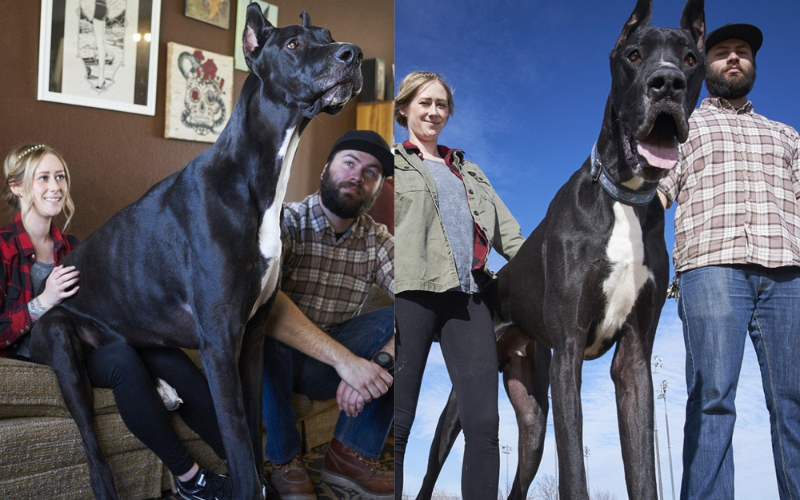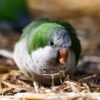- How Long Does A Quaker Parrot Live? - 17 May 2024
- 4 Hacks on Keeping Your Home Clean With Pets - 28 March 2024
- 5 Things to Know Before Bringing Home a New Kitten - 26 March 2024
Black Great Dane need substantial mental stimulation and physical exercise. Without it, they can begin to engage in destructive behaviors to fill the activity void, so start a daily routine of walks and playtime. They are prone to hip dysplasia, so be sure to work on polite leash walking early and regularly take them for 6-month health checks. These visits can catch small (often symptomless) health problems before they become serious.
Get Your Feeding Right

If you’ve researched and are sure that a Great Dane is the right breed for you, these giant dogs make incredible family pets. However, taking care of them is a big job. They require plenty of space, including a large dog bed and crate, quality food, and veterinary care. They also need plenty of training and quality time with their people.
Providing your Great Dane with the proper nutrition is one of the best things you can do for him. It is not uncommon for large breeds to suffer from nutritional imbalances, which can lead to various health problems.
Great Danes are predisposed to bloat, also known as gastric dilatation-volvulus (GDV). This condition is dangerous and often fatal, so if you notice any signs of GDV, like a distended abdomen or puking, contact your veterinarian immediately. You can prevent this painful problem by avoiding foods high in fat and limiting your food intake to two or three meals daily. Great Danes need a lot of exercise, especially as puppies. They should be walked on a leash at least twice a day and allowed to play outside.
Get Your Grooming Right

Like all dogs, Black Great Danes need regular grooming, especially brushing. However, their larger bodies can easily be injured during a grooming session, so it’s essential to find a professional groomer experienced with working with large breeds. In addition to routine brushing, Black Great Danes should have their nails clipped regularly, being careful not to cut into them quickly.
Keeping these tasks up to date can help to prevent gum disease and ear infections in your dog. Because Black Great Danes tend towards anxiety, keeping them in a stable environment and introducing them to new situations slowly so they don’t get overstimulated and act out of character is essential. This includes visits to the vet, pet sitters, and daycare. It also helps to put trinkets and knick-knacks out of reach so they don’t become accidental chew toys.
Get Your Training Right

Black Great Danes require a lot of training, exercise, and attention to keep them healthy and happy. They’re not meant to be confined in a home and left to their own devices; this often leads to destructive behaviors, anxiety, and even aggression. Starting basic obedience training early is essential, using positive reinforcement and consistency. Providing at least an hour of daily exercise, including dog walks and playtime, in a safe, secure, fenced area is essential. Games like fetch, hide and seek, puzzle toys, and obstacle courses help them burn off energy and stay mentally stimulated.
Because they’re such big dogs, feeding them properly is essential. Large-breed puppies should be fed three to four times daily, with correctly portioned meals, to avoid nutrient imbalances that can lead to orthopedic diseases. They’ll need to continue to eat multiple small meals throughout adulthood to prevent bloat and maintain proper body weight.Because of their large size, training your Black Great Dane to walk on a leash and behave in public is essential. They can be very affectionate and loving, but they’re also powerful and may accidentally knock over young or elderly people.
Get Your Exercise Right

Black Great Danes need daily physical exercise and mental stimulation to remain happy, healthy dogs. This can be in the form of a walk, game, or advanced training class. Just make sure to monitor your dog during physical activity, as their size can easily hurt a child or elderly person. These gentle giants are playful dogs that love to have fun with their owners and other animals. They are also vigilant watchdogs that alert you to any unexpected visitors or noises outside.
Although Great Danes do not usually bark in the presence of humans, they will if they feel threatened or unsafe. Because of their size, they cannot hide their emotions, so you can tell when they are feeling agitated or stressed by their body language. In these situations, it is essential to provide them with a safe, secure environment where they can relax and recover from their experience.
Get Your Sleep Right

Avoid using electronics in the evenings or before bed; don’t let your dog take long naps during the day. Like other large breeds, Great Danes are predisposed to bloat (called gastric dilatation-volvulus or GDV). This life-threatening condition requires immediate veterinary attention, as minutes can make all the difference. To prevent bloat, it’s recommended that you give your dog a rest period of 40 to 60 minutes after eating and not exercise them immediately afterward. Some veterinarians offer prophylactic gastropexy, a procedure that tacks your Dane’s stomach to prevent bloat from occurring.
Incredible Black Great Dane Stories
Over time, Emily’s emotional wounds healed, largely thanks to Bella. Their story became a testament to the power of love and the incredible bond that can form between a person and their furry companion. Bella not only saved Emily but also brought light into the lives of others, proving that sometimes, all you need to find hope is the love of a Black Great Dane named Bella. As the years passed, Bella and Emily’s friendship deepened, and they faced life’s challenges together with unwavering support. Bella’s presence continued to be a source of strength and inspiration, a reminder that even in the darkest moments, a loyal friend is ready to stand by your side. The story of Emily and Bella was a beautiful reminder that sometimes, our greatest healers come in unexpected forms, and the love of a faithful companion can mend even the most wounded hearts.
The Secret Language of Black Great Danes
The secret language of Black Great Danes isn’t spoken in words, but in their expressive eyes, wagging tails, and gentle nudges. These majestic dogs communicate their emotions with subtle gestures, conveying love with a warm gaze, excitement with joyful bounces, and a need for affection with a gentle nuzzle. Their silent language is one of loyalty, companionship, and a deep bond that transcends words, making them excellent and intuitive companions for those who understand their unspoken cues.In the presence of a Black Great Dane, one finds that the most meaningful conversations are often the ones that need no words at all.
Why Black Great Danes Are the Ultimate Therapy Dogs You Need

Black Great Danes are fantastic therapy dogs because they’re big, friendly, and their black fur makes them look cool. They make people feel safe and loved during therapy. These dogs are very calm and patient, which is essential for therapy. They can help in hospitals or when people are feeling sad. They’re good at understanding how people feel and making them feel better. So, a Black Great Dane could be a perfect choice if you need a therapy dog!
Black Great Danes are known for their calm and patient demeanor, essential in therapy settings. They are incredibly adaptable and capable of adjusting their energy levels to match the needs of their human companions. This adaptability allows them to excel in various therapy roles, from providing comfort in hospitals to assisting in emotional therapy sessions. Their innate sensitivity to human emotions enables them to detect and respond to subtle cues. All these qualities combined make Black Great Danes an excellent choice as therapy dogs, offering physical and emotional support to individuals seeking healing and comfort.
FAQS( Frequently Asked Question)
Q1. What are the key considerations for raising a happy and healthy Black Great Dane?
A. To raise a happy and healthy Black Great Dane, prioritize mental stimulation, physical exercise, proper nutrition, grooming, and training.
Q2. What is the recommended exercise routine for Black Great Danes?
A. Black Great Danes need daily exercise, including walks, playtime, and mental stimulation. Aim for at least an hour of exercise each day.
Q3. Why are Black Great Danes considered good therapy dogs?
A. Black Great Danes make excellent therapy dogs due to their calm, patient demeanor, adaptability, and sensitivity to human emotions.
Final thoughts
The Black Great Dane is a breed that truly embodies majesty and magnificence. From their rich history to their gentle temperament, they are remarkable dogs. If you’re considering adding one to your family, be prepared to welcome a loyal and loving companion.
















